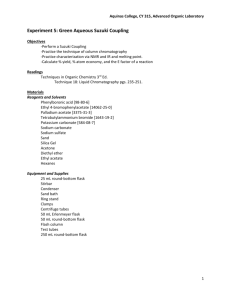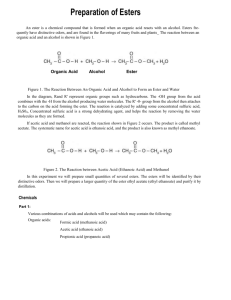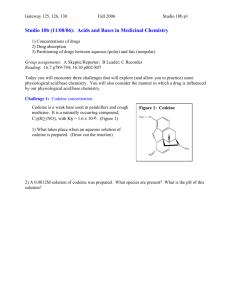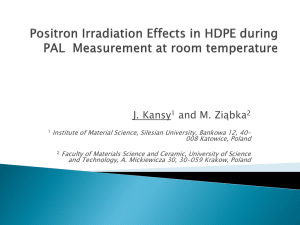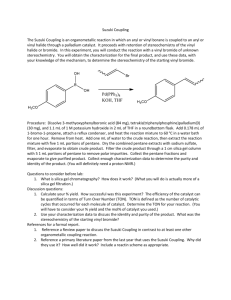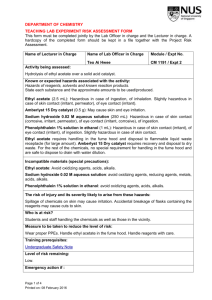Suzuki Cross Coupling Introduction: Nature makes molecules very
advertisement
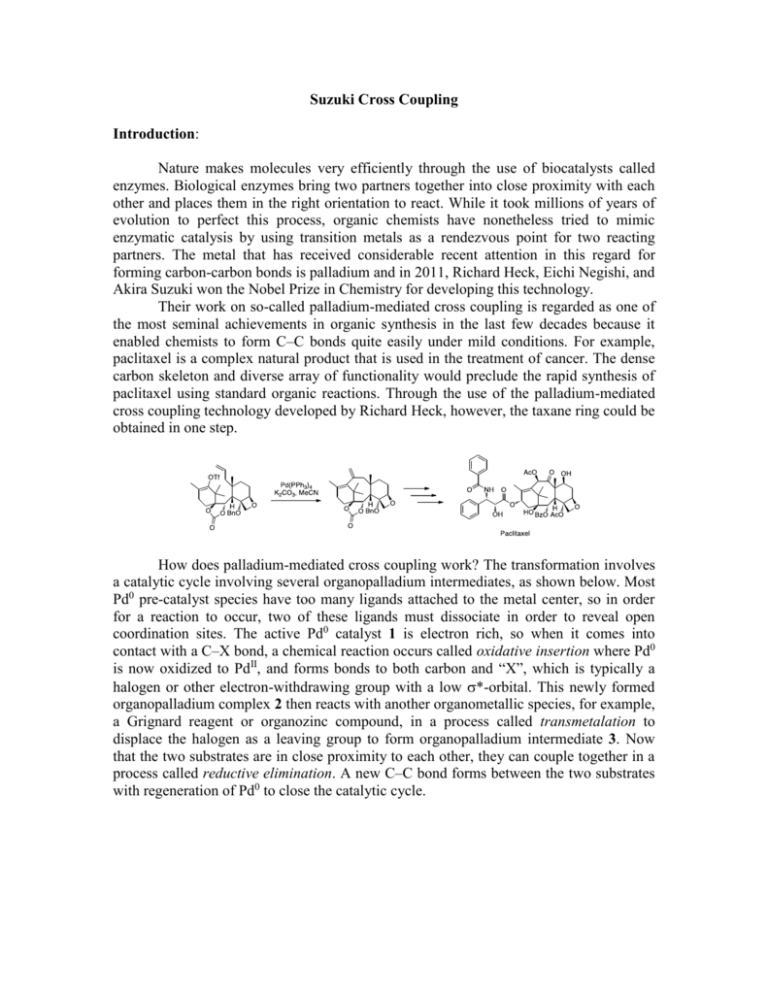
Suzuki Cross Coupling Introduction: Nature makes molecules very efficiently through the use of biocatalysts called enzymes. Biological enzymes bring two partners together into close proximity with each other and places them in the right orientation to react. While it took millions of years of evolution to perfect this process, organic chemists have nonetheless tried to mimic enzymatic catalysis by using transition metals as a rendezvous point for two reacting partners. The metal that has received considerable recent attention in this regard for forming carbon-carbon bonds is palladium and in 2011, Richard Heck, Eichi Negishi, and Akira Suzuki won the Nobel Prize in Chemistry for developing this technology. Their work on so-called palladium-mediated cross coupling is regarded as one of the most seminal achievements in organic synthesis in the last few decades because it enabled chemists to form C–C bonds quite easily under mild conditions. For example, paclitaxel is a complex natural product that is used in the treatment of cancer. The dense carbon skeleton and diverse array of functionality would preclude the rapid synthesis of paclitaxel using standard organic reactions. Through the use of the palladium-mediated cross coupling technology developed by Richard Heck, however, the taxane ring could be obtained in one step. How does palladium-mediated cross coupling work? The transformation involves a catalytic cycle involving several organopalladium intermediates, as shown below. Most Pd0 pre-catalyst species have too many ligands attached to the metal center, so in order for a reaction to occur, two of these ligands must dissociate in order to reveal open coordination sites. The active Pd0 catalyst 1 is electron rich, so when it comes into contact with a C–X bond, a chemical reaction occurs called oxidative insertion where Pd0 is now oxidized to PdII, and forms bonds to both carbon and “X”, which is typically a halogen or other electron-withdrawing group with a low *-orbital. This newly formed organopalladium complex 2 then reacts with another organometallic species, for example, a Grignard reagent or organozinc compound, in a process called transmetalation to displace the halogen as a leaving group to form organopalladium intermediate 3. Now that the two substrates are in close proximity to each other, they can couple together in a process called reductive elimination. A new C–C bond forms between the two substrates with regeneration of Pd0 to close the catalytic cycle. Catalytic Cycle for Pd-Mediated Cross Coupling Suzuki Cross Coupling Akira Suzuki recognized that this type of catalytic transformation must be practical if it is to be used outside an academic environment. So, he developed a mild set of conditions that is now used extensively in the synthesis of complex molecules which have found use as new medicines and materials, which can be applied in electronics. The Suzuki reaction is now the standard bearer for certain C–C bond formations. It uses an organometallic species known as a boronic acid during the transmetalation step. Since many boronic acids are available commercially or can be easily prepared in one step, the synthetic utility of this reaction is quite high. The catalytic cycle is identical to the general cycle above, except that base is required during the transmetallation step. Catalytic Cycle for the Suzuki Reaction In this week’s experiment, you will be performing a Suzuki cross coupling reaction involving a substituted aryl bromide and phenylboronic acid to generate unsymmetrical biaryl compounds. You will each be given a unique aryl bromide with which you will run the Suzuki reaction. Why is the Suzuki reaction an important reaction to learn? This reaction is a prominent representative of a transition metal cross coupling reaction, reactions which are now among the most highly exploited chemistries in the pharmaceutical industry. Metal-catalyzed reactions are becoming so useful in organic transformations that the traditional boundaries between organic and inorganic chemistry no longer bear value. Thus, it is important for organic chemists to be able to communicate with inorganic chemists (and biochemists and physical chemists, etc.), and vice versa. True success in an academic or industrial setting will require collaboration between different subdisciplines. This is your first reaction using a transition metal catalyst and so attention must be paid to minimize exposure to air. In addition, you will be performing a true reflux in this experiment, and so we will show you how to set up a reflux condenser. Finally, sequestration of the metal catalyst after the reaction in a workup step will be critical to obtaining pure product. In this experiment, you will review how to perform a recrystallization. Analysis by 1H NMR, IR, and LC/MS will be used for characterization. References: 1. www.nobelprize.org 2. Callam, C. S.; Lowary, T. L. J. Chem. Ed. 2001, 78 (7), 947-948. 3. Huff, B. E.; Koenig, T. M.; Mitchell, D.; Staszak, M. A. Org. Syn. 2004, 10, 102; Huff, B. E.; Koenig, T. M.; Mitchell, D.; Staszak, M. A. Org. Syn. 1998, 75, 53. Suzuki Cross Coupling Equipment: Microscale glassware kit 25 and 50 mL beakers 10 mL graduated cylinder 1 mL syringes and needles 2.5 or 5 mL syringes Pasteur pipets Capillary tubes TLC plates (thin) Cotton Scintillation vials and caps NMR tubes HPLC vials Thermowells Stir bars Teledyne Isco RediSepRf 12 gram Silica Flash Columns Chemicals: 1-Bromonaphthalene 4-Bromotoluene 4-Bromoanisole Bromobenzene 4-Bromobenzaldehyde Phenyl boronic acid Triphenylphosphine Palladium(II) acetate Sodium carbonate (2 M aqueous) – 500 mL Activated charcoal Ethyl acetate (4 L) Celite Anhydrous sodium sulfate Methylene chloride (2 x 500 mL) Sodium chloride solution (saturated aqueous brine, 2 x 500 mL) Methanol (2 x 200 mL) Hexanes (4 L) Deionized water CDCl3 Procedure: adapted from Callam, C. S.; Lowary, T. L. J. Chem. Ed. 2001, 78 (7), 947948. Suzuki Reaction: In a 10 mL round bottomed flask containing a stir bar, dissolve the aryl bromide (2.5 mmol, 1.0 equiv.) in 5 mL n-propanol, then add the phenyl boronic acid (1.15 equiv.). Stir the mixture until the solids are nearly all dissolved, then add to this solution palladium(II) acetate (1 mol%), triphenylphosphine (3 mol%), and 2 M aqueous sodium carbonate (1.3 equiv.). Affix a reflux condenser to your round bottomed flask and attach tubing for running water according to the figure. Heat the solution to reflux (what is the boiling point of n-propanol?) for 1 h. Monitor your reaction by TLC after 30 minutes using 20% ethyl acetate/hexanes as the elution solvent. Workup if complete. Workup: Transfer the warm reaction mixture to a Falcon tube and rinse the flask with an additional 5 mL water and 5 mL ethyl acetate. Dilute the mixture with another 5 mL ethyl acetate and separate the two layers. Re-extract the aqueous phase with an additional 5 mL ethyl acetate and then combine the organic extracts. Wash these extracts with brine (2 x 5 mL). Transfer the organic extract into an Erlenmeyer flask or beaker and dry over anhydrous sodium sulfate. Filter the solution under vacuum into a side arm flask using a Hirsch funnel, filter disc, and approximately 1 cm of Celite. Rinse the Celite pad with ethyl acetate (5 mL). Evaporate the solution on a rotary evaporator, or while warming on a hot plate to obtain a pale yellow-brown oil. Redissolve in a minimal amount (<2 mL) methylene chloride and set aside. Column Chromatography: While your reaction is running, equilibrate a pre-packed silica gel column with 100% hexanes by eluting solvent through the column with a 20 mL syringe until no air bubbles are visible. You may reuse this hexanes if your collecting flask/beaker is clean. After workup, load your crude biaryl product in methylene chloride onto the column with a 1 mL syringe. Be sure to save a small sample (a residual amount in the syringe will be enough) as a TLC standard. Rinse the beaker with 1 mL methylene chloride and load onto the column. Via 20 mL syringe, elute a volume of 20 mL hexanes first followed by increasing amounts of ethyl acetate in 20 mL portions until the ratio reaches 75% hexanes – 25% ethyl acetate (3–4 steps). Collect your eluent in labeled test tubes. Determine the contents of each fraction by TLC analysis. Combine the appropriate fractions in a tared beaker and evaporate the solvent on a hot plate or rotary evaporator to obtain pure product. Use a stream of air over the beaker to increase the rate of evaporation, but do not overheat your sample. Dry your sample in an oven for 5 minutes to remove excess solvent. Analysis: Obtain a yield of you biaryl product, record its IR spectrum, and submit a sample 1H and 13C NMR (in ~0.7 mL CDCl3), and LC/MS (<1 mg in 1.5 mL MeOH) analyses. Pre-Lab Exercise: These questions do not need to be explicitly answered in writing, but you should be able to answer them prior to your arrival in lab. They will help you understand what is happening during the experiment. Some of these questions will form the basis for your lab report. 1. Draw the full catalytic cycle for the Suzuki reaction for your substrates. 2. What is the role of the aqueous sodium carbonate in this reaction? Why does sodium carbonate need to be added as an aqueous solution? 3. What is the role of the triphenylphosphine in this reaction? 4. Why do we place the circulating water “in” the bottom and “out” the top of the condenser? 5. What are biaryl compounds useful for? 6. When performing column chromatography, why does the column need to be equilibrated before loading a sample? 7. There are two main types of elution: isocratic and gradient. What is the difference between these two techniques and which one will you use in your experiment? 8. How will you know which fractions contain the same compound? What impurities do you think you will need to separate your product from (hint: what else is in the reaction mixture that might not be removed by aqueous workup?)? Post-Lab Assignment: Ask your instructor.


